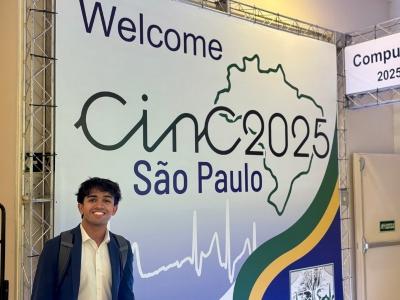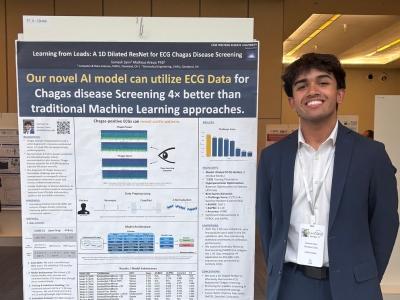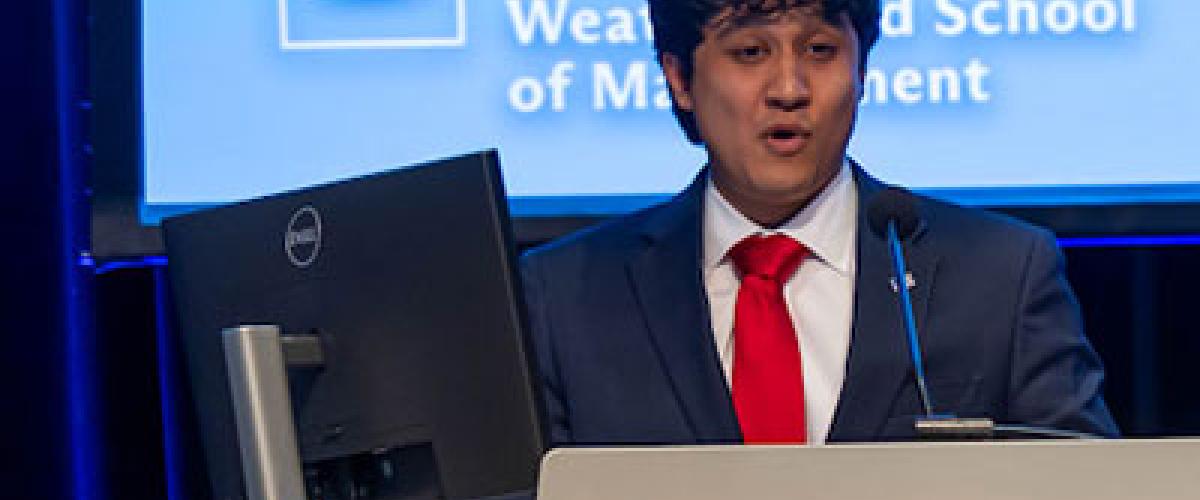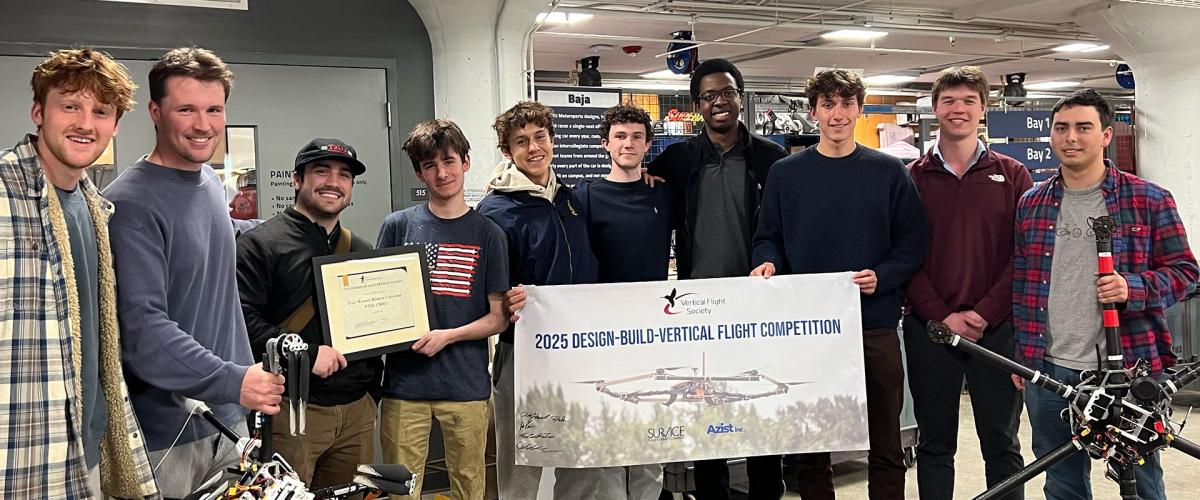Meet a second-year computer science student helping make disease detection more accessible worldwide
Last month at just 18 years old, Case Western Reserve University student Somesh Saini stood before an international audience in São Paulo, Brazil, to share his groundbreaking research on Chagas disease. A parasitic infection spread by an insect bite, the disease can lead to serious heart complications, including cardiomyopathy, which weakens the heart muscle and impairs its ability to pump blood effectively.

A second-year student majoring in computer science with minors in biology and chemistry, Saini presented the machine-learning pipeline he developed in collaboration with researchers at Cleveland Clinic to detect the disease at the International Computing in Cardiology Conference.
Saini’s interest in the medical field began with a love of chemistry and a fascination with how molecular interactions influence human health. His curiosity deepened after taking an introductory Java course at CWRU, where he discovered the power of algorithms to solve real-world problems.
“What excited me most was the potential to bridge these two domains,” said Saini, who expects to graduate in spring 2028. “Utilizing computation not just as a simple programming tool, but as a lens to explore and solve complex biomedical problems.”
Driven by a passion to combine computer and biomedical sciences, Saini applied deep learning, a type of artificial intelligence that uses multiple layers of neural networks, to analyze electrocardiogram (ECG) signals tied to the heart’s physiological and chemical processes.

Through persistence, late nights, and countless questions to his mentor, Matheus Araújo—assistant professor of biomedical engineering at Cleveland Clinic Lerner College of Medicine—Saini developed AI-based detection methods for Chagas and similar diseases, which often go undiagnosed due to costly testing and limited access to care.
“Being able to represent CWRU on a global stage so early in my journey is an amazing privilege, and the encouragement I’ve received here has meant the world to me,” he shared. “Neglected diseases don’t lack solutions—they lack advocates.”
Read on to learn more about Saini’s research and the inspiration behind his mission to make disease detection more accessible worldwide.
Answers have been edited for clarity and length.
Q. Why did you choose Chagas disease specifically for your project?
I chose Chagas disease because it sits at a perfect intersection of my interests: global health, technological equity, and biological understanding. It's a disease that disproportionately affects rural communities in Latin America—areas where access to advanced medical infrastructure is limited and diagnoses are often missed entirely.
The silence around this disease struck me the most. Many have [Chagas], but are not made aware due to expensive detection services. Millions suffer from its chronic condition, but a small fraction actually receive the necessary attention, funding and research momentum seen with first-world diseases. As someone passionate about the intersection of technology and social impact, I felt an obligation to use my skills in service of communities that have long been underserved. Therefore, my knowledge of both chemical processes and machine learning was a perfect mix for the problem.
Q. In what ways do you hope your work can make diagnostic testing more accessible for underserved communities?
When studying the environmental landscape of diagnosed patients, I instantly recognized the poor access to care and harmful social stigmas around Chagas disease. It’s not just a biomedical problem—it is a systemic one. The idea that an algorithm could bring low-cost, high-accuracy diagnostics to these settings felt like a tangible way to reduce that gap.
I truly believe the ability to detect a disease shouldn’t depend on your zip code. A diagnosis can change the entire trajectory of a person’s life, and having early detection services is crucial. This kind of healthcare should not be gated by cost, infrastructure or awareness. It's easy to get caught up in the comfortable, first-world concerns. Regardless, it’s crucial we don’t lose sight of our brothers and sisters in the global south to help bridge healthcare disparities.
Q. What led you to choose Case Western Reserve University, and how has CWRU supported your interdisciplinary interests?
The opportunities at CWRU are something rare. I’m able to pursue my unique intersection of passions in healthcare computing, while contributing to world-class research efforts. The proximity to Cleveland Clinic and other hospitals meant I could explore real-world biomedical problems early. And, the faculty here have been nothing but encouraging. At CWRU, I feel empowered to forge my own, non-traditional pathway.
Courses in biology and chemistry gave me a strong grounding in ion channel flow, cardiac muscle and regulatory mechanisms that influence the heart's electrical activity. This helped lead me through analyzing waveforms of Chagas-positive patients to recognize signal conduction disruptions, which are hallmarks of Chagas cardiomyopathy.
Q. How would you describe your experience presenting your research at the International Computing in Cardiology Conference?
Being able to present at such a young age and connect with leading healthcare computing researchers was an awesome and unforgettable experience that opened numerous doors for me. Since it was an international conference, I was able to network with experts from all over the world, which exposed me to novel techniques in disease prediction and cardiovascular devices being developed globally. Overall, it was remarkable to finally see the success of my research after working consistently for the past nine months.
On a personal level, it's a great validation that students can drive real contributions to global health. Professionally, it opened doors to connect with top-class researchers, cardiologists and technologists across disciplines. It’s a rare space where technological ideas translate directly into patient impact, and I feel honored to be part of that dialogue.
Q. Looking forward, what do you hope to achieve?
This project has sharpened my vision on my future. I want to build a career at the intersection of biomedical AI, global health and clinical innovation. At CWRU, that means continuing to merge my coursework in chemistry, biology and computer science, and pursuing deeper collaborations across engineering and medical spaces. Longterm, I see myself continuing to contribute to AI-driven health initiatives—whether that’s through academia, industry or entrepreneurial ventures. My goal isn’t just to innovate, but to distribute innovation more fairly.




